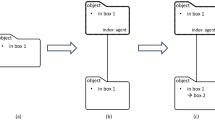Abstract
To compare Japanese autistic children's use of semantic knowledge and theory of mind with mentally retarded and typically developing children's, they were tested on their comprehension of active and passive sentences and false belief understanding. Autistic children were sensitive to plausibility levels of semantic bias as were 4-year-olds with typical development when comprehending sentences, although impaired in belief understanding as compared with mentally retarded children and typically developing 5-year-olds. Children's sentence comprehension had no association with belief understanding. Results suggest that autistic children with certain verbal intelligence can utilize semantic common sense to comprehend sentences as can typically developing children and that the ability to comprehend sentences is relatively independent of theory of mind.
Similar content being viewed by others
REFERENCES
American Psychiatric Association. (1994). Diagnostic and statisti-cal manual of mental disorders (4th ed. ). Washington, DC. Author.
Baron-Cohen, S., Leslie, A. M., & Frith, U. (1985). Does the autistic children have a “theory of mind” ? Cognition, 21, 37–46.
Baron-Cohen, S., Tager-Flusberg, H., & Cohen, D. J. (Eds. ). (1993). Understanding other minds:Perspectives from autism. Oxford, UK: Oxford University Press.
Clancy, P. M. (1985). The acquisition of Japanese. In D.I. Slobin (Ed. ), The crosslinguistic study of language acquisi-tion (pp. 373–524). Hillsdale, NJ: Lawrence Erlbaum Asso-ciates.
Dewart, M. H. (1979). Language comprehension processes of mentally retarded children. American Journal of Mental De-ciency, 84, 177–183.
Doherty, M., & Perner, J. (1998). Metalinguistic awareness and theory of mind:Just two words for the same thing? Cognitive Development, 13, 279–305.
Dunn, L. M., Dunn, L., Whetton, C., & Pintillie, D. (1982). Brit-ish picture vocabulary scale. London: NFER-NELSON.
Eisenmajer, R., & Prior, M. (1991). Cognitive linguistic correlates of ‘theory of mind’ ability in autistic children. British Journal of Developmental Psychology, 9, 351–364.
Hakuta, K. (1982). Interaction between particles and word order in the comprehension and production of simple sentences in Japanese children. Developmental Psychology, 18, 62–76.
Happé, F. G. E. (1995). The role of age and verbal ability in the theory of mind task performance of subjects with autism. Child Development, 66, 843–855.
Kokuritsu Kokugo Kenkyujo [The National Institute for Japa-nese Language ]. (1980). Youji no goi nouryoku [Preschoolers' vocabulary ]. Tokyo:Tokyo Shoseki.
Kokuritsu Kokugo Kenkyujo [The National Institute for Japa-nese Language ]. (1981). Youji/Jido no renso goi hyo [Tables of preschool and school children's associative vocabulary ]. Tokyo:Tokyo Shoseki.
Leslie, A. M., & Frith, U. (1988). Autistic children's understand-ing of seeing, knowing, and believing. British Journal of Developmental Psychology, 6, 315–324.
Naito, M., Komatsu, S., & Fuke, T. (1994). Normal and autistic children's understanding of their own and other's false belief: A study from Japan. British Journal of Developmental Psy-chology, 12, 403–416.
Paul, R., Fischer, M. L., & Cohen, D. J. (1988). Sentence com-prehension strategies in children with autism and specific language disorders. Journal of Autism and Developmental Disorders, 18, 669–679.
Powers, J. E., & Gowie, C. J. (1977). Children's strategies in pro-cessing active-and passive-voice sentences:Use of semantic and syntactic information. Genetic Psychology Monograph, 96, 337–335.
Prior, M., Dahlstrom, B., & Squires, T.-L. (1990). Autistic chil-dren's knowledge of thinking and feeling states in other people. Journal of Child Psychology and Psychiatry, 31, 587–601.
Slobin, D. I. (1981). The origins of grammatical encoding of events. In W. Deutsch (Ed.), Behavioural development:The child's construction of language (pp. 185–199). London: Aca-demic Press.
Slobin, D. I. (1982). Universal and particular in the acquisition of language. In E. Wanner & L. R. Gleitman (Eds.) Lan-guage acquisition:The state of art (pp. 128–170). Cambridge, UK: Cambridge University Press.
Sparrevohn, R., & Howie, P. M. (1995). Theory of mind in chil-dren with autistic disorder:Evidence of developmental pro-gression and the role of verbal ability. Journal of Child Psychology and Psychiatry, 36, 249–263.
Strohner, H., & Nelson, K. E. (1974). The young child's develop-ment of sentence comprehension:In. uence of event proba-bility, nonverbal context, syntactic form, and strategies. Child Development, 45, 567–576.
Tager-Flusberg, H. (1981). Sentence comprehension in autistic children. Applied Psycholinguistics, 2, 5–24.
Tager-Flusberg, H. (1988). On the nature of a language acquisi-tion disorder:The example of autism. In F. S. Kessel (Ed.), The development of language and language researchers: Essays in honor of Roger Brown (pp. 249–267). Hillsdale, NJ: Lawrence Erlbaum Associates.
Tager-Flusberg, H. (1989). A psycholinguistic perspective on lan-guage development in the autistic child. In G. Dawson (Ed.), Autism:Nature, diagnosis and treatment (pp. 92–115). New York:Guilford Press.
Tager-Flusberg, H. (1996). Current theory and research on lan-guage and communication in autism. Journal of Autism and Developmental Disorders, 26, 169–172.
Ueno, K., Nadeo, T., & Iinaga, K. (1991). Kaiga goi hattatsu kensa [Picture vocabulary test ]. Tokyo:Nihon Bunka Kagakusha.
van der Lely, H., & Dewart, H. (1986). Sentence comprehension strategies in speci cally language impaired children. British Journal of Disorders of Communication, 21, 291–306.
Author information
Authors and Affiliations
Rights and permissions
About this article
Cite this article
Naito, M., Nagayama, K. Autistic Children's Use of Semantic Common Sense and Theory of Mind: A Comparison with Typical and Mentally Retarded Children. J Autism Dev Disord 34, 507–519 (2004). https://doi.org/10.1007/s10803-004-2546-9
Issue Date:
DOI: https://doi.org/10.1007/s10803-004-2546-9




